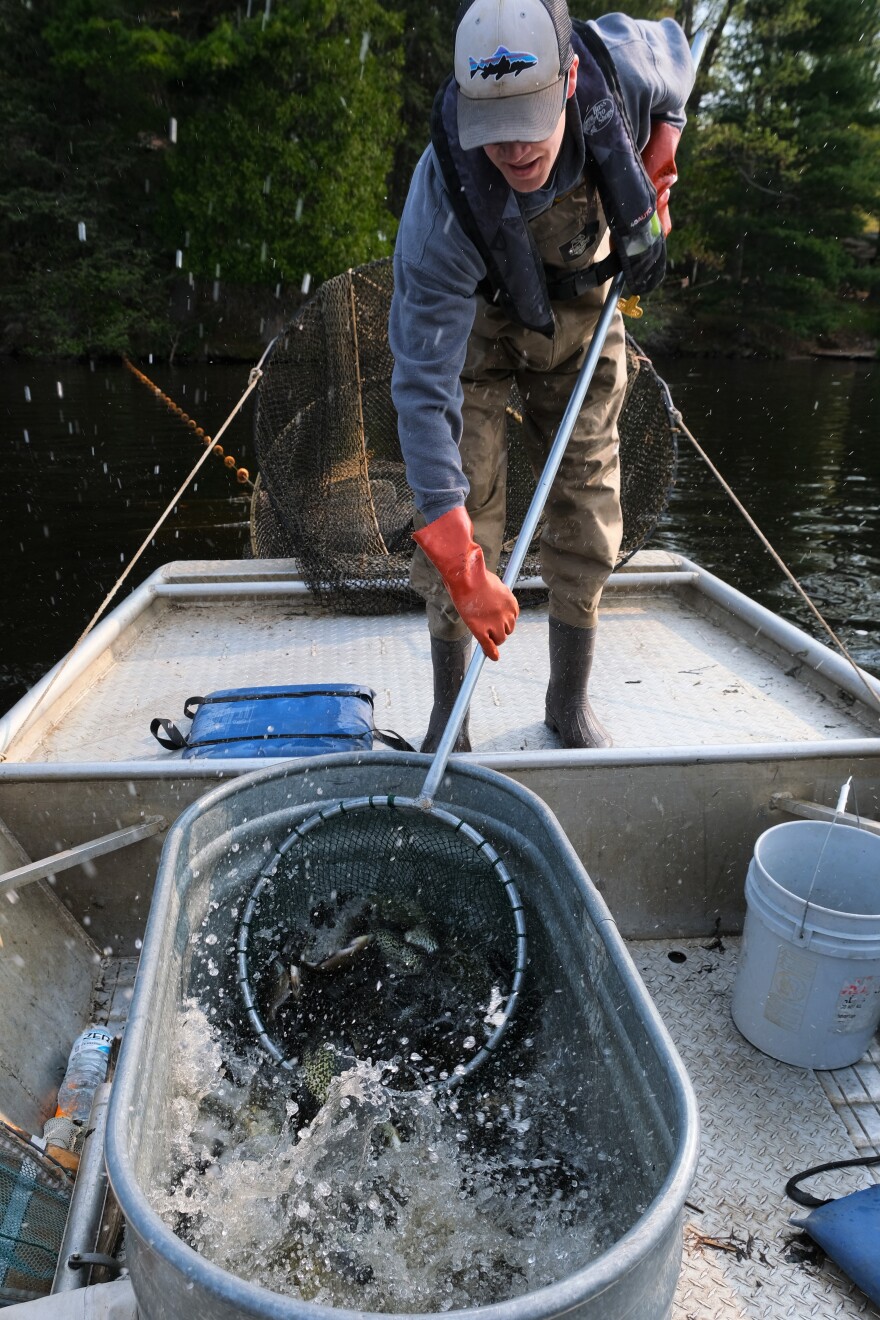On a sunny, calm morning Chad Leanna pulls a boat out of the Hodag Park Boat Launch and heads for a back bay of Boom Lake.
Leanna is the DNR Fisheries Technician for Oneida County. He along with Oneida County Fisheries Biologist Nathan Lederman are checking a fyke net they first put out five days ago and have been checking every day.
“For this specific survey of lakes, we’re out here panfish netting,” said Lederman.
The fyke net is a series of tunnels that fish can swim into but not back out. The start is placed along the shore forcing fish into the tunnels when they try to go around.
Leanna pulls the boat up next to the DNR buoy so Lederman can pull the opening of the net onto the flat bow of the boat.

Once it’s secured with hooks, Lederman uses a pole net to scoop out all the fish and put them in a large metal tub filled with lake water.
“This net did pretty well Chad,” Lederman comments as he scoops out multiple nets full of fish.
Then the counting begins.
Lederman lays each fish out on a board with a ruler built in then calls out the measurement before tossing the fish back into the lake.
Leanna records the species and size of each fish in a tablet.
Once they reach about 50 of species, Lederman stops measuring and just counts how many there are.
“We measure a random sample of it. So we’re just considering our scoops random rather than selecting big ones or small ones,” said Leanna.
The pair repeat this process four times between Boom and Bass Lakes.
While their main priority is the panfish for today’s survey, they track everything they’re catching.
Surveys like this are done every year in Oneida County, but due to the high volume of lakes they can only get to each one every 6 to 12 years.
“Kind of have that set up throughout all of Oneida County where based off the size of a lake, bigger lakes will be a shorter span, say 6 or 8 years, where smaller lakes, lower profile lakes will be visited less often, 10 to 12 years,” said Lederman.

The surveys have multiple purposes.
In general, they’re done to see how fish populations are doing, which can in turn help inform bag limits and other regulations.
“We’ll use this information to get a general understanding of the panfish fishery within the Rhinelander chain as well as evaluate the fishing regulation, the special panfish regulation that was put in place in 2016 to see if it’s having the desired impacts,” said Lederman.

Panfish aren’t the only species they do these surveys for.
“We’ll start out right away targeting pike and walleye on specific lakes and then transition to muskies and later to panfish. So we’re out on a variety of lakes sampling numerous species,” explained Lederman.
They’re also helping other DNR researchers with their studies.
They snip off part of the tail fin of any Northern Pikes they catch and place the samples in a small tube to preserve it.

Those samples will be used to look at the fish’s genetics.
“To kind of see where they’re coming from. Are they coming from a few individual parents? Or are they the correct strain, genetic strain within the Upper Wisconsin River? Or did they come from elsewhere?” said Lederman.
Days like this one are Lederman and Leanna’s favorite where the sun is shining and they have the lakes just about to themselves.
It makes the days they have to be out there in the freezing rain or sometimes even snow worth it.
“These are definitely the days that people feel jealous that we have this job,” said Lederman.
But what they look forward to most is interacting with people, especially anglers out on the water.
“I do enjoy the people interactions. We get a lot of positive feedback from fishermen. We get some negative feedback too, but you get to learn from people what they want,” said Leanna.
One of those interactions was with a man out on his dock next to where one of the nets was set.
After Lederman collected the fish from the net, Leanna pulled up to the dock to show the man the catch.

They look forward to interactions like that because at the end of the day that’s who they’re doing this work for.
“We’re trying to make fishing better for the people that are actually out fishing,” said Leanna.
“It’s a balancing act. We’re trying to balance the biology, what we’re doing to the system is not negatively impacting the system, but also making it useable for the users of the lakes whether that be recreational boaters, fishermen, kayakers,” added Lederman. “It’s a multiuse system so trying to find that balance between all of those uses while also keeping the aquatic resources safe for future generations.”
The data collected during the surveys will be compiled later this summer and into the winter.




